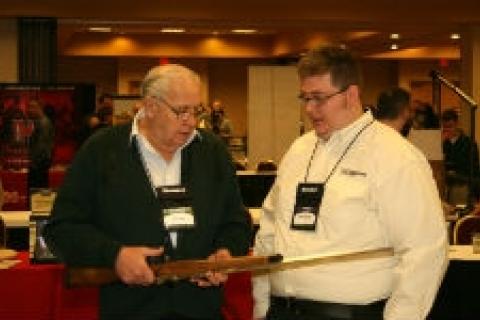
There is nothing like a beautiful piece of English walnut that has been gracefully shaped into a stock for a Pre-64 model 70 Winchester or a custom Mauser, finished with a beautiful hand-rubbed oil finish. Perfection lies in wonderfully executed checkering, not coarse like that found on rifles today. Tasteful checkering patterns, like a classic Fleur-de-Lis pattern with the leaves on the pattern well rounded, are appealing to the eye.
 |
| Jerry Fisher, left, looks over a rifle at a show. |
Form follows function — and so it should be with rifle stocks. Only true artisans like Jerry Fisher understand and makes dream like these reality.
On the other hand, Roy Weatherby and his famous rollover cheek piece, Monte Carlo comb and tapered forearms made the ever-popular Mark V. The gun fit the times and Weatherby's customers demanded more of his "California style" stocks.
Stock design on a rifle, like beauty, is in the eye of the beholder. Even if your tastes differ from mine, there are elements that all stocks have in common.
Lend Me Your Comb
Straight comb stocks, like those found on classic style, have minimum drop at the heel of the stock and are designed to align your eye with a scope on your rifle. This stock also lends itself to the use of open sights as well, like those found on the larger caliber safari guns for hunting dangerous game.
This design also sends recoil in a straight line to your shoulder, minimizing muzzle rise. You may never realize this in a mild-kicking rifle, but once you step up to a 338 Win Mag or the 375 H&H, you will be glad your stock is straight.
The Monte Carlo comb slants down toward the front of the stock, but does the same thing — aligns your eye with your scope. The exaggerated slant keeps the comb away from your cheekbone — important when firing teeth-rattling calibers.
Getting a Grip
Pistol grips are an often-overlooked component of rifle stocks, but an oversized pistol grip can cause you to lose your grip on a rifle while shooting. I have large hands, yet I'm quite partial to petite-sized pistol grips, even on big magnums.
The pistol grip should form an arc but not too tight. If the pistol grip is too tight, your hand will feel cramped and will not relax when shooting.
California-style stock pistol grips are teardrop-shaped and usually tighter than a classic style. A Wundhammer palm swell, which is incorporated into many California-style stocks, fills the palm area of the pistol grip and allows your hand to return to the same position for better-shot repeatability.
Forearms
The forearms of rifle stocks differ greatly. A classic stock's forearm is pear shaped and usually proportionate to the rest of the stock. Here again, I prefer a slimmer forearm, while other shooters might choose a hand-filling forearm to keep recoil under control.
The California stock forearm is tapered and flat-bottomed and is more at home on a sandbag sitting on a shooting bench.
No matter what your tastes, the stock has to fit you. Stock design is not carved in stone; there are no rules stating you can't have a shiny classic stock or a Wundhammer palm swell on a classic stock.
Remington and Browning produce both types and variants of both stocks. Ruger prefers to stay with classic lines but, in contrast, Weatherby still produces the stocks that made their rifles famous.
If you are in the market for a new rifle, try all the styles to see which one fits you best. Armed with a little knowledge and knowing what is available can help make your choice a little easier.
Now what caliber should you choose?
- 3119 views

